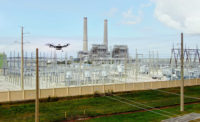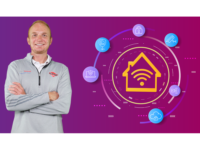It’s 2020 and employees expect a lot from their workplace. No longer are they OK with clumsy key cards, hunting for parking spaces and searching for the correct conference room. As the average consumer’s home grows smarter, they expect the same from their workplace, too.
“Smart security technology for the workplace has been one of the biggest developments we’ve seen in recent years,” says Chris Salazar-Mangrum, vice president of USAV at PSA, the world’s largest integrator consortium. “From facial recognition to location tracking, many employees don’t realize just how smart their workplaces are both in terms of physical security and cyber security. Many of the integrators we work with at PSA are offering smart workplace solutions that make offices much safer spaces.”
There are a few reasons why we got to this point (see “How Did We Get Here?” on the following pages), but now that we’re here, it might be time to start considering how your company can earn additional revenue in the smart workplace space.
Connectivity
At the core of the smart workplace is connectivity — all of the other components simply do not work without it. This is the approach that Genetec, Montreal, Canada, has taken.
“Genetec as a company is arguably the most open platform in the security industry, which means we integrate and collaborate with many different technologies that exist in that building, whether it’s an elevator system, a building automation system, a typical key system or a lighting system; we have a means to tie those different technologies together, manage them and control them,” says Ty Miller, business development manager, Genetec.
Miller adds that the core essential of a secure workplace is a seamless environment for both the building owner and those working in the space.
“In my opinion, there are really two types of companies in the security space,” Miller says. “You have your proprietary, not-open platforms where you have to buy their software and their cameras and they don’t play nice with other technologies. And then there are the open systems with an open architecture that embrace other technologies and want to bring them into their ecosystem. Obviously with a smart building environment, the latter is going to be the successful company.”
Though it has already moved its data platform to the cloud, Kastle Systems, Falls Church, Va., is currently working on developing an open interface to be better suited for smart workplaces.
“We were the first physical security provider to move our data platform to the cloud, which made us better prepared to enter the world of smart building technology well before it was a mainstream undertaking; our signals moved to the Internet, which made us better able to scale nationwide and serve thousands of customers from three to four geo-dispersed operations centers, providing data storage redundancy, as well,” says Kyle McAdams, marketing director, Kastle Systems. “A more current innovation for us is developing an open interface that enables Kastle Access Control to thrive in the world of the smart workplace, moving from a proprietary system to an open-interoperable system.”
Johnson Controls, Milwaukee, also has been involved in creating smart workplaces for some time.
“We have a good foundation — a really great integration toolkit,” says Rick Focke, senior product manager, Johnson Controls. “We pass information to other systems, which is one of the things you have to look for in a smart building because data is king, and you have to own that data and use it. One of the more common use cases we run into is where we count occupancy for a building and use it for other systems, like in the cafeteria, to know how much food they should order for the day, or to determine how much fresh air we need. Because if there are fewer people in the building there’s less fresh air needed by code, and you can save a little money on that. Then where there’s an emergency, we have tools that get people out of the building, make a list of who’s left and who’s still unaccounted for.”
How Did We Get Here?
There are a number of varied factors that have made smart workplaces popular. Here, security professionals share their own theories.
“The ubiquity of powerful cell phones has driven down the price of embedded hardware to a point where similar chips can also power security cameras. These chips have the capability to run modern AI and computer vision algorithms with a higher level of performance and accuracy than ever before.” — Adam Wynee, Security and Safety Things
“Global warming has created the green building movement, and IoT development has enabled the development of smart systems to sense and communicate with each other in real time to help buildings run more efficiently and reduce carbon production. Given that buildings produce 39 percent of all carbon dioxide worldwide, this has become a high priority for cities. Smart building systems were already in development due to this situation, and the cloud, Wi-Fi, IoT and virtual workforce all combined to create the smart building and smart city movement.” — Kyle McAdams, Kastle Systems
“Digital transformation is driving workplaces to become smarter, plus more businesses are embracing a more collaborative environment to be more agile. Likewise, we have different generations in our workforce today who have different expectations of what a workday should look like. Many still want a traditional 8 a.m. to 5 p.m. schedule, while some believe they should be able to work anytime, anywhere.” — Chris Salazar-Mangrum, USAV, PSA
“If you think about the intelligence that our homes can achieve in this day and age, it’s only logical to see why smart workplaces are also taking off (and why companies like ours are expanding to include business units that help address these needs). Employees and leaders within an organization must be able to seamlessly collaborate across teams and geographies in our increasingly global workforce. That’s why technology tools that make this more streamlined exist — and why it’s critical for integrators to shift toward offering services that take this into account.” — Matt Boyer, director of technology, Vistacom, Allentown, Pa.
“I think the number one factor is competition. The tenants are becoming more demanding on what they expect; everyone wants the best amenities, the smartest building with the nicest facilities. From a tenant standpoint, they want to attract people to come work for their company, and the only way they’re going to do that is providing a different experience at work.” — Ty Miller, Genetec
Access Control
“In this ecosystem, where IoT connects cyber systems and physical security operations, workplace security must begin with user identity data that is registered at the authoritative source for the organization running the office,” McAdams says. “Those data rights should integrate with both the physical and online access security.”
Once this is established, that identity and the rights associated with that user can enable access from many points, such as smartphone apps, which can then signal access rights via Bluetooth to door locks, elevators, office printers and more.
“This communicates access data to other smart office devices and systems to create an overall personalized experience for that particular identity,” McAdams says. Those rights then can be activated immediately — as well as deactivated, in the case of a staff firing or security threat.
Ideally, McAdams says the authoritative identity management should reside remotely, such as on a cloud platform, so users’ access rights can transmit to anywhere with internet connectivity.
“This way, access rights can be controlled centrally by the administrator and vary by role, location and time to address the worlds of co-working, telecommuting and flex space where access rights can vary space to space and hour to hour,” McAdams says. “Authentication rights can be updated for all users, in mass or individually.”
KastlePresence mobile access credentials use a Bluetooth signal to interact with other IoT-based office systems, such as hands-free door lock access and smart elevators.
“In general, smart workplaces include more open spaces,” says William Plante, senior principal, enterprise security risk group, ADT Commercial. “The more traditional design practice of special segregation (access control locks on many subdivided spaces) is becoming passé. The use case today is that a user only needs to pass by one access control point, giving them broad access into a building. Specific spaces, such as IT closets and labs, will have door controls, but the need to pass through three access controlled doors to sit at a desk is waning.”
Iris ID, Cranbury, N.J., is incorporating biometrics to provide an end-to-end access control solution that bridges both physical and logical security needs.
“Physical security has traditionally been focused on protecting assets such as people, facilities, equipment and inventory,” says Mohammed Murad, vice president of global development and sales, Iris ID. “That’s left the protection of logical assets in the hands of the IT department. Today’s enterprise organizations need the confidence that the person accessing an onsite workstation is authorized to do so. It no longer makes sense to maintain physical and logical security in separate silos. It’s time for an integrated approach; that is one reason why smart buildings are incorporating biometrics to provide an end-to-end solution.”
Iris readers and other biometrics can unlock the front entry to enable an approved employee to enter the building, access the elevators and enter appropriate offices. When integrated with software on the workstation, the reader also can assure only authorized employees access the computer, network and data.
Murad added that some smart buildings have even begun using iris-based recognition systems for employee time and attendance, making computing payroll, vacation time and benefits easier.
Denis Hebert, president of Feenics, Ottawa, Canada, says that successful access control products in the smart workplace will provide services for owners outside of just access control.
“There’s a certain amount of info that comes out of an access control system, like how many people came into the building, and whether there’s no one in the room,” Hebert says. “How [smart workplaces] operate in the future is giving more of that information to the building owner so they can optimize.”
Video & AI
Another important element of a smart workplace is the powerful combination of video and artificial intelligence.
Kastle, for example, has video surveillance cameras that leverage Kastle’s cloud platform to capture and store only video snippets of actual events that meet pre-determined AI criteria, avoiding sifting through hours of video showing only empty space. These cameras can be synced to access control signals, as well, to record entries and exits, so if a door is left open after work hours the property manager can check the security cameras from their smartphone to see if there is a real threat.
Genetec has a suite of video analytics that can identify whether a parking space is vacant, whether additional resources are needed at a reception desk, and more.
“When you talk analytics alone, there’s so many different use cases,” Miller says. “It could be identifying whether a package was left in the lobby suspiciously, or whether there are people loitering outside that shouldn’t be. Parking is its own animal, so we have a lot of tools built around license plate recognition and enabling parking in a gated lot.”
Genetec recently developed a plug-in for real-time location services, providing the ability to put a tracking beacon on a person or piece of equipment, and then know in real time exactly where that person or object is in a building.
“That specific technology is really prevalent in healthcare, but it also has a great use case in any type of campus or work environment,” Miller says. “A lot of these solutions we develop have been for other verticals or specific niche markets, and when you look at a smart building it can be a culmination of all those solutions.”
To keep security integrators informed about these developing trends, PSA is launching an AI research committee this year that will feature smart workplaces as a regular topic. The group will be providing general and specific educational opportunities for smart workplaces.
“In the age of the Internet of Things and rapidly developing technologies, we have to be agile in our product offerings, education and more,” Mangrum says. “Many are now working in places that use AI to learn employees’ habits and this will only continue to grow. For example, a business could tailor digital signage to change based on the time of day and/or who is walking by the sign. At 10 a.m., all of the digital signs in the hallways change to display the local coffee shop menu. AI and AR will begin to play a role in how technology is deployed in smart workplaces. While this example specifically shows how smart technology can improve the employee experience, security will also improve. AI can track employees’ regular patterns or behaviors to be able to detect a breach.”
The Challenges
Security integrators and manufacturers all agree that cyber security is the greatest obstacle to overcome when securing a smart workplace.
“Much of smart building technology, such as IoT, does not have native cyber security onboard,” ADT’s Plante says. “Therefore, there is a physical security threat to the IoT network — and by extension, the hosting infrastructure — if an attacker were to gain physical access to an IoT device and potentially introduce malware. Smart buildings still need basic redundancies built into the systems to account for potential smart device failures. For example, a wireless smart lock is a terrific device that improves installation costs, but the design needs to account for wireless failure.”
Focke of Johnson Controls also emphasizes the importance of having cyber policies and practices in place for the overall system — not just bits and pieces.
“Some of the systems that we integrate with haven’t even thought of cyber,” Focke says. “They just assume they’re in a secure network, but that’s a big assumption to make. Elevator systems, for example, are kind of rudimentary in that regard.”
McAdams adds, “All these IoT-based systems are overlapping and integrating, greatly increasing the potential points of cyber intrusion points. But our cloud-based platform moves our clients’ access control and video surveillance servers off site to a more robust, cyber-secure environment, thus giving clients’ IT infrastructure greater security from cyber hacking than the standard access server sitting on their on-site platform.”
This also allows Kastle and its clients to monitor access data from anywhere with internet access, and allows Kastle to push new software updates immediately from the cloud to the client’s system without any disruption, ensuring they have the most sophisticated version available to protect against intrusion — physical or logical.
And while making smart workplaces cyber secure is one challenge, convincing employees they’re secure is a completely different issue.
“Our biggest challenge in establishing a secure, smart workplace is that we need to show employees that our solutions respect their privacy, and that only anonymized data is transmitted from the camera,” says Adam Wynee, software engineering manager, Security and Safety Things, Munich, Germany.






